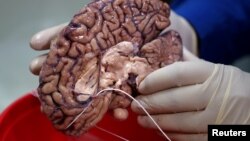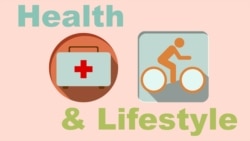From VOA Learning English, this is the Health & Lifestyle report.
Our brains are protected by our skull. But that is not the only protection it has.
A natural barrier around our brains prevents germs and other damaging substances in the blood from entering the brain. Doctors call this protection the "blood-brain barrier."
However, it does more than protect.
This barrier also stops medicines from entering the brain. Doctors have trouble using drugs to treat brain tumors, Alzheimer’s and other diseases affecting the brain. So researchers have been trying to find safe ways to get drugs through the barrier.
Research on mice
At Imperial College, London, researchers have been performing experiments with mice. Doctor James Choi is a leader of this research effort. He describes the blood-brain barrier as a secure entry point -- what he calls border patrol. This keeps out harmful germs or pathogens. But it also keeps out good things.
"You can think of it as a kind of gateway, or border patrol that is saying the brain needs glucose, that's allowed in. All the foreign pathogens -- you're stopped at the door. You're not allowed to come into the brain."
He and other researchers have shown that high frequency sound waves can help open parts of the blood-brain barrier. For this to work, the sound waves must pass through a thick substance or gel. The researchers say the method is much like ultrasound imaging tests used on pregnant women.
First, researchers injected very small bubbles into the bloodstream. Then they added soundwaves to make the bubbles vibrate. This caused cells in the blood vessel walls to stretch, enabling drugs to reach the brain.
Research on humans
Similar experiments are being performed at Sunnybrook Health Sciences Centre in Toronto, Canada.
Back in 2015, researchers at Sunnybrook became the first to break the blood-brain barrier to treat a brain tumor.
In late July 2018, Sunnybrook reported on the latest research. The New York Times newspaper reports that Dr. Nir Lipsman led the study. In the statement, Lipsman described the project as a "major goal of neuroscience” for years adding that it is "exciting."
Six Alzheimer's patients were part of a small test at Sunnybrook. Lipsman and his team wanted to see if targeted sound waves could break a hole in the blood-brain barrier for a brief period.
Dr. Sandra Black worked with Lipsman on this trial. She says the experiment showed that the barrier opened. It let some harmless fluid flow in, and then it closed back up.
"It just took two ultrasound treatments to show that the blood-brain barrier can be opened. It's very exciting, I feel quite emotional about it because there's a lot riding on this, and it's a whole new world of possibilities. But we have to take one step at a time, we have to make sure it's safe."
The researchers add that as the technology improves, doctors will be able to target very small areas of the brain. They hope to target only the areas that need treatment.
Dr. James Choi adds that this kind of targeting will be an important part of future treatments.
"We can make large beams, small beams. We can steer the beam to any location in the brain. So the technology's so advanced at this point where we can actually deliver the drug to any region of the brain."
It may be a long time before doctors can use this form of treatment. However, as Alzheimer's cases increase around the world, scientists are trying every way possible to help patients.
I'm Anna Matteo.
Faith Lapidius reported on this story for VOANews.com. Anna Matteo adapted the story for Learning English. Her story includes information from other media sources. George Grow was the editor.
_______________________________________________________________
Words in This Story
skull – n. the structure of bones that form the head and face of a person or animal
glucose – n. a type of sugar that is found in plants and fruits
high frequency – n. a radio frequency between very high frequency and medium frequency
ultrasound medical noun : a method of producing images of the inside of the body by using a machine that produces sound waves which are too high to be heard
inject – v. to force a liquid medicine or drug into someone or something by using a special needle — often + into
bubble – n. a tiny, round ball of air or gas inside a liquid
vibrate – v. to move back and forth or from side to side with very short, quick movements
a lot riding on (something) – phrase to be depending on the successful outcome or development of something
beam – n. a line of energy, particles, etc., that cannot be seen
steer – v. to control the direction in which something (such as a ship, car, or airplane) moves








